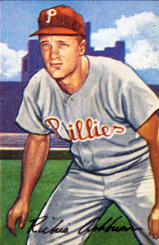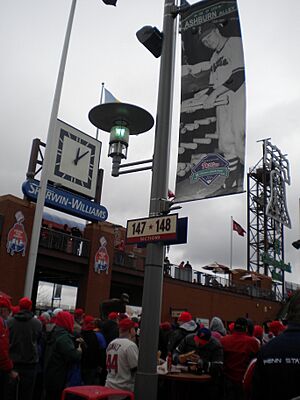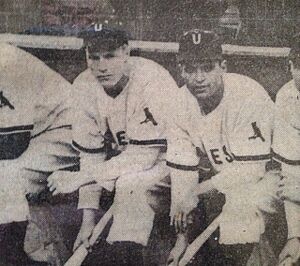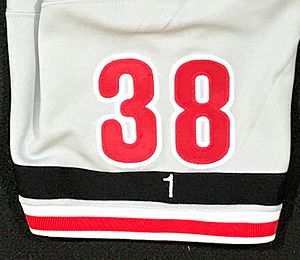Richie Ashburn facts for kids
Quick facts for kids Richie Ashburn |
|||
|---|---|---|---|

Ashburn with the Philadelphia Phillies, c. 1953
|
|||
| Center fielder | |||
| Born: March 19, 1927 Tilden, Nebraska, U.S. |
|||
| Died: September 9, 1997 (aged 70) New York City, U.S. |
|||
|
|||
| debut | |||
| April 20, 1948, for the Philadelphia Phillies | |||
| Last appearance | |||
| September 30, 1962, for the New York Mets | |||
| MLB statistics | |||
| Batting average | .308 | ||
| Hits | 2,574 | ||
| Home runs | 29 | ||
| Runs batted in | 586 | ||
| Teams | |||
|
|||
| Career highlights and awards | |||
|
|||
| Induction | 1995 | ||
| Election Method | Veterans Committee | ||
Don Richard Ashburn (born March 19, 1927 – died September 9, 1997) was a famous American baseball player and later a television sports commentator. People knew him by nicknames like "Putt-Putt," "the Tilden Flash," and "Whitey" because of his light blond hair.
He played in Major League Baseball (MLB) as a center fielder from 1948 to 1962. He is best known for his time with the Philadelphia Phillies. With the Phillies, he was chosen for the All-Star team four times. He was also part of the 1950 team, called the "Whiz Kids," which won the National League pennant.
Ashburn was a top hitter, winning the National League (NL) batting champion title twice. He ended his career with a .308 batting average, which is very good. He was also an amazing defensive player, often leading the league in putouts (catching balls to get players out). His 5,803 career putouts rank him third among all center fielders in MLB history. He also played for the Chicago Cubs and the New York Mets.
After he stopped playing, Ashburn became a popular color commentator for Phillies games from 1963 until he passed away in 1997. He became one of the most loved sports figures in Philadelphia. In 1995, after many fans worked hard to get him in, Ashburn was inducted into the National Baseball Hall of Fame.
Contents
Playing Career Highlights
Starting in Baseball
Richie Ashburn was born in Tilden, Nebraska. He was the youngest of four children and had a twin sister named Donna. He began playing baseball in 1935 when he was eight years old. His father told him to play as a catcher, thinking it would help him reach the major leagues faster.
Ashburn played baseball and basketball in high school. Later, he played for the American Legion Baseball team in Neligh. At an All-Star game in 1944, Philadelphia Athletics manager Connie Mack saw how fast Ashburn was. Mack suggested he play a different position, not catcher.
Ashburn signed a contract with the Cleveland Indians when he was 16. But the baseball commissioner, Kenesaw Mountain Landis, canceled it. Rules said players still in high school could not sign. He then signed with the Chicago Cubs, but that contract was also canceled. After these issues, Ashburn went to college for a short time. Then, he signed with the Philadelphia Phillies.
In 1945, at age 18, Ashburn started his professional career with the Utica Blue Sox. His manager, Eddie Sawyer, moved him to center field to use his amazing speed. His teammates started calling him "Whitey" because of his light blond hair, a nickname that stuck with him.
Ashburn joined the United States Army during the 1945 season but was allowed to finish playing. The Blue Sox won their league's championship, and Ashburn led the team with a .312 batting average. He served in Alaska in 1946. He returned to the Blue Sox in 1947, where they won another championship. Ashburn had a great year, hitting .362 and setting a league record with 191 hits.
Becoming a Major League Star
The Phillies brought Ashburn to the major leagues on April 8, 1948. He made his debut on Opening Day as a 21-year-old rookie. He started as the left fielder and became the team's leadoff hitter, batting first in the lineup. After 12 games, he became the regular center fielder.
By June 5, Ashburn was hitting .380 and had a 23-game hitting streak. His defensive skills also amazed the fans. He was the only rookie picked for the 1948 National League All-Star team. In that game, he hit a single on the first pitch and scored the first run.

In 1950, in the last game of the season, Ashburn made a key play. He threw out a runner at home plate, keeping the game tied. This helped his teammate Dick Sisler hit a home run that won the pennant for the Phillies. This team was famously known as the "Whiz Kids."
The next year, Ashburn showed off his fielding in the 1951 All-Star Game. He made a fantastic leaping catch far out in center field, stopping a near home run. He was also the last Phillies player to get eight hits in a double-header (two games in one day) on May 20, 1951.
Ashburn was known as a "singles hitter" rather than a "slugger" (someone who hits many home runs). He got over 2,500 hits in 15 years but only 29 home runs. He was a "spray hitter," meaning he could hit the ball to all parts of the field, making it hard for teams to defend against him. He had the most hits (1,875) of any player in the 1950s.
Ted Williams, another famous player, gave Ashburn the nickname "Putt-Putt." He said Ashburn "ran so fast you would think he had twin motors in his pants."
During a game in 1957, Ashburn hit a foul ball that accidentally hit a fan named Alice Roth, breaking her nose. When play started again, he hit another foul ball that hit her again while she was being carried away! Ashburn and Roth became friends after this unusual event.
Later Playing Years
After the 1959 season, Ashburn was traded to the Chicago Cubs. He played center field for them in 1960 and 1961. He even started giving baseball lessons on TV after games for young fans.
In 1962, the new New York Mets team bought Ashburn. He was the very first batter in the Mets' history. He had a good year hitting, with a .306 batting average. He was also the Mets' first All-Star player. However, it was a tough year for him. The Mets were a new team and lost a lot of games (40 wins and 120 losses). Ashburn, who started his career with a winning team, found it frustrating. He decided to retire at the end of the season.
One funny story from his time with the Mets involves his teammates. Ashburn, the center fielder, would often collide with shortstop Elio Chacón on short fly balls. Chacón, from Venezuela, didn't speak much English. So, a teammate taught Ashburn to say "Yo la tengo," which means "I've got it" in Spanish. The first time Ashburn used it, it worked! But then, left fielder Frank Thomas, who didn't speak Spanish, crashed into Ashburn. Thomas then asked, "What the heck is a Yellow Tango?" This story later inspired the name of the American indie rock band Yo La Tengo.
Before he retired, Ashburn would officiate high school basketball games in Nebraska during the off-season. This helped him stay in shape. He was a respected official but stopped when he retired from baseball.
Broadcasting Career
In 1963, Ashburn became a radio and TV color commentator for the Phillies, his old team. He worked with famous announcers like Bill Campbell and Byrum Saam. Later, he worked with Harry Kalas from 1971 until his death in 1997. Kalas and Ashburn became best friends. Kalas often called Ashburn "His Whiteness."
Ashburn was known for his funny and dry humor as a broadcaster. Once, he told a story about how he used to keep his lucky baseball bat in bed with him. He didn't trust the clubhouse staff to give him the same bat the next day!
He also had a funny habit of asking on air if the staff of Celebre's Pizza, a nearby pizzeria, was listening. Soon after, pizza would arrive at the broadcast booth! The Phillies asked him to stop because Celebre's wasn't a team sponsor. So, Ashburn found a clever way around it. He started saying, "I'd like to send out a special birthday wish to the Celebre's twins – Plain & Pepperoni!"
Ashburn also wrote columns about the Phillies and Major League Baseball for local newspapers.
Later Life and Legacy
Richie Ashburn passed away on September 9, 1997, at age 70, after broadcasting a Phillies-Mets game. Many fans came to pay their respects to him in Philadelphia. He is buried in Gladwyne, Pennsylvania.

Ashburn was elected to the Baseball Hall of Fame in 1995. This happened after a long campaign by fans who used bumper stickers that said, "Richie Ashburn: Why The Hall Not?" He was inducted at the same ceremony as another Phillies legend, Mike Schmidt. Over 25,000 fans, mostly from Philadelphia, traveled to Cooperstown, New York, for the event.
He was also inducted into The Broadcast Pioneers of Philadelphia Hall of Fame in 1997. In 2004, he was part of the first group inducted into the Philadelphia Sports Hall of Fame.
Each year, the Phillies give out the Richie Ashburn Special Achievement Award. This award goes to someone in the organization who shows great loyalty, dedication, and passion for baseball.
The center field area at Citizens Bank Park, the Phillies' home stadium, is called Ashburn Alley. Many fans wanted the new stadium to be named after Ashburn. His 47 years of service to the Phillies were second only to Connie Mack, another baseball legend.
The Phillies' radio broadcast booth at Citizens Bank Park is named the "Richie 'Whitey' Ashburn Broadcast Booth" in his honor. It is right next to the television booth, which is named after his good friend, Harry Kalas.
Rubén Amaro Jr., a former Phillies general manager, helped start the Richie Ashburn Foundation. This foundation helps underprivileged children attend baseball camp for free and gives money to schools and colleges in the area.
Images for kids






